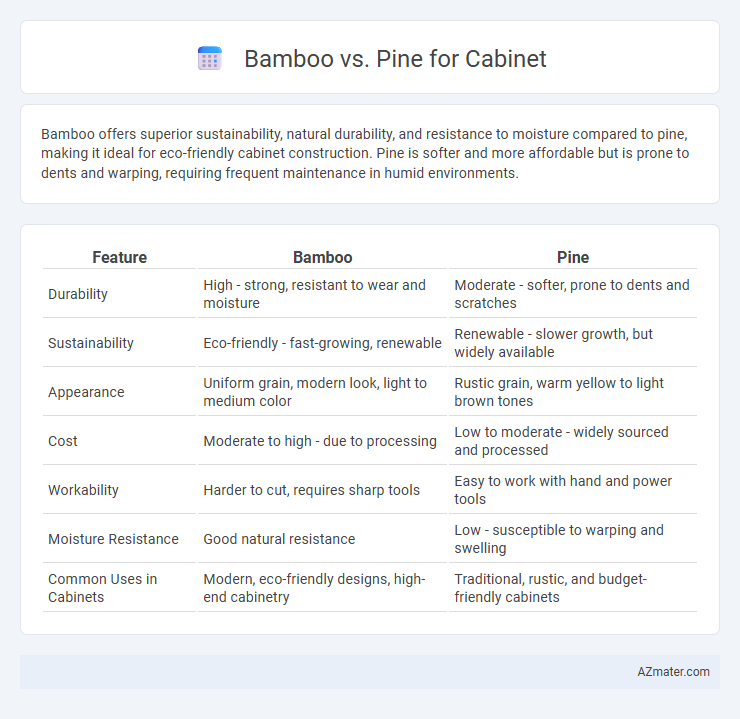Bamboo offers superior sustainability, natural durability, and resistance to moisture compared to pine, making it ideal for eco-friendly cabinet construction. Pine is softer and more affordable but is prone to dents and warping, requiring frequent maintenance in humid environments.
Table of Comparison
| Feature | Bamboo | Pine |
|---|---|---|
| Durability | High - strong, resistant to wear and moisture | Moderate - softer, prone to dents and scratches |
| Sustainability | Eco-friendly - fast-growing, renewable | Renewable - slower growth, but widely available |
| Appearance | Uniform grain, modern look, light to medium color | Rustic grain, warm yellow to light brown tones |
| Cost | Moderate to high - due to processing | Low to moderate - widely sourced and processed |
| Workability | Harder to cut, requires sharp tools | Easy to work with hand and power tools |
| Moisture Resistance | Good natural resistance | Low - susceptible to warping and swelling |
| Common Uses in Cabinets | Modern, eco-friendly designs, high-end cabinetry | Traditional, rustic, and budget-friendly cabinets |
Introduction to Bamboo and Pine Cabinets
Bamboo cabinets offer exceptional durability and eco-friendliness, crafted from fast-growing, renewable bamboo grass known for its strength comparable to hardwoods. Pine cabinets provide a traditional aesthetic with softwood that features natural knots and a warm, rustic appearance, making it a popular choice for classic or country-style kitchens. Both materials vary in hardness and grain patterns, affecting their performance and maintenance in cabinetry applications.
Material Characteristics: Bamboo vs Pine
Bamboo offers exceptional durability and resistance to moisture due to its dense fiber composition, making it highly suitable for kitchen cabinets prone to humidity. Pine features a softer texture with visible knots and a lower density, which results in easier workability but less resistance to dents and wear compared to bamboo. Bamboo's sustainable, fast-growing nature coupled with its hardness rating of 1380 on the Janka scale surpasses pine's 420, highlighting its superior strength and long-term performance for cabinetry.
Sustainability and Environmental Impact
Bamboo cabinets are highly sustainable due to bamboo's rapid growth rate, reaching maturity in 3 to 5 years, which minimizes deforestation and promotes carbon sequestration. Pine, a slower-growing softwood, requires longer harvesting cycles, leading to increased environmental impact through habitat disruption and carbon release. Bamboo's renewable nature and lower chemical treatment needs make it a greener choice compared to pine for environmentally conscious cabinetry.
Durability and Strength Comparison
Bamboo exhibits superior durability and strength compared to pine, making it an excellent choice for cabinets that require long-lasting performance. Its dense fiber composition provides high resistance to impacts and wear, surpassing the softer, more porous structure of pine, which is prone to dents and scratches. Bamboo's natural moisture resistance also contributes to its longevity in humid environments, whereas pine may warp or swell over time.
Aesthetics and Grain Differences
Bamboo cabinets exhibit a distinctive uniform grain with a smooth, linear pattern that enhances modern, minimalist aesthetics, while pine features more pronounced knots and irregular grain patterns that contribute to a rustic, traditional look. The natural color of bamboo ranges from light tan to golden hues, providing a sleek and contemporary appearance, whereas pine typically displays a warmer range of creamy white to yellow tones, adding warmth and character to cabinetry. Both materials offer unique visual appeal, but bamboo's consistent grain and color make it ideal for clean, modern designs compared to pine's varied texture and more organic charm.
Cost and Affordability Analysis
Bamboo cabinets generally offer a more cost-effective solution compared to pine due to bamboo's rapid growth and sustainable harvesting, resulting in lower material prices. Pine, while often more affordable upfront, can incur higher long-term costs because of its susceptibility to dents and moisture damage, which may require more frequent repairs or replacements. When balancing initial investment and durability, bamboo presents a more affordable option for homeowners seeking eco-friendly and long-lasting cabinetry.
Maintenance and Care Requirements
Bamboo cabinets require minimal maintenance due to their natural resistance to moisture and insects, needing only regular dusting and occasional wiping with a damp cloth to maintain their appearance. Pine cabinets, however, demand more frequent care, including protection from moisture and periodic sealing or staining to prevent warping, dents, and discoloration. Proper maintenance of pine also involves careful cleaning with non-abrasive products to preserve its softer wood surface and enhance durability.
Suitability for Different Cabinet Styles
Bamboo's smooth, consistent grain and natural light color make it ideal for modern and minimalist cabinet styles, offering a sleek and eco-friendly option. Pine's distinctive knots and warm tones complement rustic, farmhouse, and traditional cabinetry, adding character and a cozy aesthetic. Both materials adapt well to various finishes, allowing flexibility in achieving specific design themes while balancing durability and style.
Popular Uses in Modern Cabinetry
Bamboo is highly favored in modern cabinetry for its sustainability, durability, and distinctive grain patterns, making it ideal for eco-friendly kitchen and bathroom cabinets. Pine, valued for its affordability and ease of staining, is commonly used in farmhouse and rustic-style cabinets, offering a warm, natural aesthetic. Both materials cater to different design preferences, with bamboo excelling in sleek, contemporary spaces and pine favored in traditional or country-inspired interiors.
Final Verdict: Choosing the Right Material
Bamboo offers superior sustainability, rapid growth cycles, and higher durability compared to pine, making it ideal for eco-conscious cabinetry with long-lasting strength. Pine provides a classic look, easier workability, and a lower upfront cost but is more prone to dents and moisture damage over time. For cabinets balancing environmental impact and longevity, bamboo stands out as the right material, while pine suits budget-friendly projects favoring traditional aesthetics.

Infographic: Bamboo vs Pine for Cabinet
 azmater.com
azmater.com